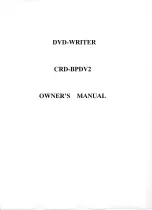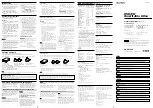
VLT
®
4000 VT
■
General information about electrical installation
■
High voltage warning
The voltage of the AFD is dangerous
whenever the equipment is connected
to line. Incorrect installation of the motor
or the AFD may cause damage to the equipment,
serious personal injury or death.
Consequently, the instructions in this manual,
as well as national and local safety regulations,
must be complied with. Touching the electrical
parts may be fatal - even after disconnection from
line: using 200 and 400 V units, wait at least 20
minutes, 30 minutes for 600 V units.
NOTE
It is the user
’
s or certified electrician
’
s
responsibility to ensure correct grounding
and protection in accordance with applicable
national and local norms and standards.
■
Grounding
The following basic issues need to be considered
when installing a AFD.
•
Safety grounding:
Please note that the
AFD has a high leakage current and must be
grounded appropriately for safety reasons.
Apply local safety regulations.
•
High-frequency grounding:
Keep the ground
wire connections as short as possible.
Connect the different ground systems at the lowest
possible conductor impedance. The lowest possible
conductor impedance is obtained by keeping the
conductor as short as possible and by using the
greatest possible surface area. A flat conductor, for
example, has a lower HF impedance than a round
conductor for the same conductor cross-section C
VESS
.
If more than one device is installed in cabinets, the
cabinet rear plate, which must be made of metal,
should be used as a common ground reference
plate. The metal cabinets of the different devices are
mounted on the cabinet rear plate using the lowest
possible HF impedance. This avoids having different HF
voltages for the individual devices and avoids the risk
of ra-dio interference currents running in connection
cables that may be used between the devices. The
radio interference will have been reduced.
In order to obtain a low HF impedance, use the
fastening bolts of the devices as HF connection to
the rear plate. It is necessary to remove insulating
paint or similar from the fastening points.
■
Cables
Control cables and the filtered line cable should be
installed separate from the motor cables so as to
avoid interference overcoupling. Normally, a distance
of 8 inches will be sufficient, but it is recommended
to keep the greatest possible distance wherever
possible, especially where cables are installed in
parallel over a substantial distance.
With respect to sensitive signal cables, such as
telephone cables and data cables, the greatest possible
distance is recommended with a minimum of 3 feet per
15 feet of power cable (line and motor cable). It must
be pointed out that the necessary distance depends on
the sensitivity of the installation and the signal cables,
and that therefore no precise values can be stated.
If cable jaws are used, sensitive signal cables
are not to be placed in the same cable jaws as
the motor cable or brake cable.
If signal cables are to cross power cables, this should
be done at an angle of 90 degrees.
Remember that all interference-filled in- or
outgoing cables to/from a cabinet should be
shielded/armored or filtered.
■
Shielded/armored cables
The shield must be a low HF-impedance shield. This is
ensured by using a braided shield of copper, aluminium
or iron. Shield armor intended for mechanical
protection, for example, is not suitable.
MG.40.A7.22 - VLT is a registered Danfoss trademark
36
















































